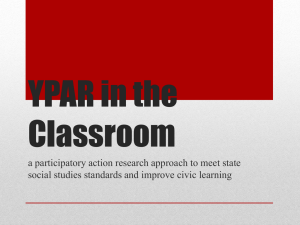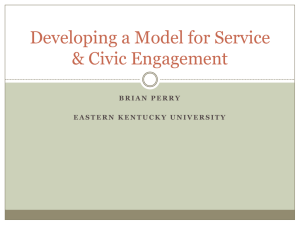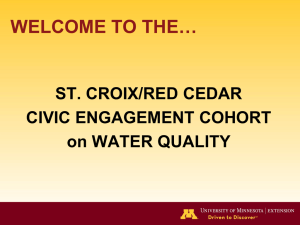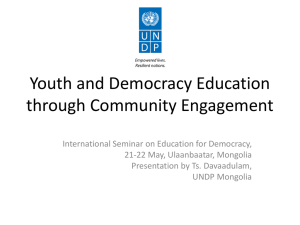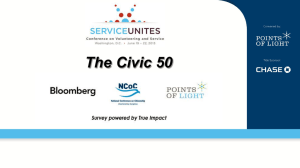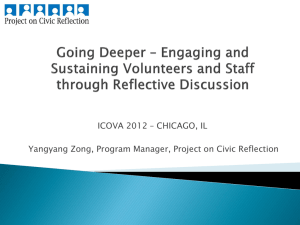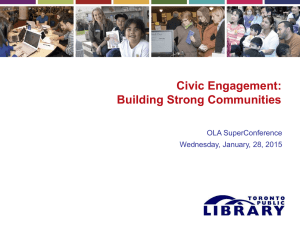The Civic Achievement Gap
advertisement
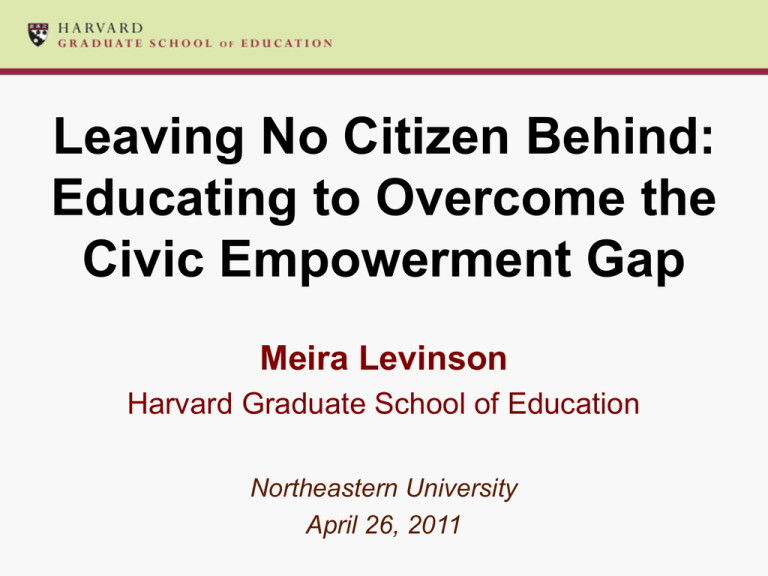
Leaving No Citizen Behind: Educating to Overcome the Civic Empowerment Gap Meira Levinson Harvard Graduate School of Education Northeastern University April 26, 2011 footdrag A competent and responsible citizen: withdraw 1. is informed and thoughtful 2. participates in his/her community 3. has moral and civic virtues boycott mobilize others vote inform/persuade others run for office blog 4. acts politically by having the skills, knowledge, and commitment needed to accomplish public purposes (Civic Mission of Schools; Keeter et. al.) create art (visual, rap, etc.) Key attributes of good citizens: • Knowledge • Skills • Attitudes • Behaviors Strong, direct correlation among these: Knowledge + Skills + Attitudes = Engagement Civic Empowerment Gap: Knowledge and Skills • Data from 4th, 8th, 12th grades (NAEP), 9th grade (IEA), and adults (Delli Carpini and Keeter) • Uniform results: Higher scores on content knowledge and skills: Lower scores on content knowledge and skills: Whites and Asians Blacks and Hispanics Two-parent families Single-parent families Middle class (>200 books in home) Poor (<100 books in home) Civic Empowerment Gap: Behaviors 2004 Election: Voting Rates of Citizens Whites: 67% Income >$75,000: 80% Blacks: 60% Income <$15,000: 45% Hispanics: 47% Asians: 44% Natural born: 65% Naturalized: 54% < high school: 39% high school grad: 56% college: 72% post-grad: 84% Source: U.S. Census; http://elections.gmu.edu/CPS_2008.html Civic Empowerment Gap: Behaviors 2008 Election: Voting Rates of Citizens Whites: 66% Income >$75,000: 75% Blacks: 65% Income <$15,000: 41% Hispanics: 50% Asians: 44% Natural born: 65% Naturalized: 54% < high school: 39% high school grad: 55% college: 72% post-grad: 83% Source: U.S. Census; http://elections.gmu.edu/CPS_2008.html Civic Empowerment Gap: Behaviors under $15,000 campaign work campaign contribution contact protest board member political org affiliation informal community activity 4% 6 25 3 1 29 13 over $75,000 17% 56 50 7 6 73 38 Latinos < Blacks and Whites; Blacks more “outsider” activities; immigrants < native born Civic Empowerment Gap: Attitudes • Political and social trust • Political efficacy • Personal efficacy • Political/Civic identity • Civic duty Positive correlation with civic and political participation Negative correlation with poverty, minority status, immigrant status Sources: Verba et. al.; Dawson; Smith and Setzer; Putnam; Washington Post, Kaiser Family Foundation and Harvard University; Sidanus et. al.; Sanchez-Jankowski; Lopez. Attitudinal Gap: Efficacy and Identity “The nation paused on 9–11, but not now. No one cares about our losses. I am a homeowner who is homeless. I am a taxpayer and a voter. I placed my trust in the elected officials to do what is right but instead we got nothing. We are not refugees, we are Americans.” (Hurricane Katrina survivor, African American, New Orleans, 2004) • “The government response to Hurricane Katrina would have been faster if the victims had been white” Blacks: 84% agree Whites: 20% agree • “Hurricane Katrina disaster showed that racial inequality remains a major problem” Blacks: 90% agree Whites: 38% agree The Civic Empowerment Gap: Why does it matter? • Legitimacy • Stability • Equality • Democracy What predicts participation? Motivation Opportunities Where should we take action? • Non-school sites of socialization clearly matter, and may matter more than schools • But schools matter too Schools’ potential impact: • • • • • • • • • • Overall educational level Civics courses Pedagogies: discussion, debate, simulations, etc. Extracurricular/after school participation Experiential opportunities Classroom and school climate Political/civic participation Leadership opportunities Personal invitation to participate Family practices (e.g. discussion at home) Civic education in practice: High Frequency: • reading textbooks • completing worksheets • listening to lectures • using quantitative data, charts or graphs Low Frequency: • engaging in discussion • participating in simulations or mock trials • taking action Civic Learning Opportunity Gap: “High school students attending higher SES schools, those who are college-bound, and white students get more [civic learning] opportunities than low-income students, those not heading to college, and students of color.” (Kahne and Middaugh, 2008) Students in high vs. average SES classes are: • twice as likely to report studying how laws are made • almost twice as likely to report participating in service activities • nearly 1½ times more likely to report having experiences with debates or panel discussions in their social studies classes Where should we take action? • Non-school sites of socialization clearly matter, and may matter more than schools • But schools matter too • De facto segregated urban schools may give most “bang for the buck” De facto segregated urban schools Schools w/90-100% minority population serve: > 1/3 of all Black and Latino kids in US > 1/2 of all Black and Latino kids in Northeast 100 largest school districts hyper-segregated: 56% of schools are 81-100% non-White Over 1/5 of these districts have student population > 90% non-White, > 70% in poverty “triple segregation” by race, poverty, language Recommendations: 1. Improve urban schools and reduce drop-out rates 2. Increase civic education: earlier, more, more often 3. Incorporate students’ own interests, knowledge, and experiences into curriculum Local knowledge and issues Current events Community concerns and attitudes Historical understanding 4. Provide students empowering civic experiences Pedagogies Class and school climate Democratic governance Civic engagement beyond school walls (guided experiential civic ed) 5. Provide teachers empowering civic experiences


